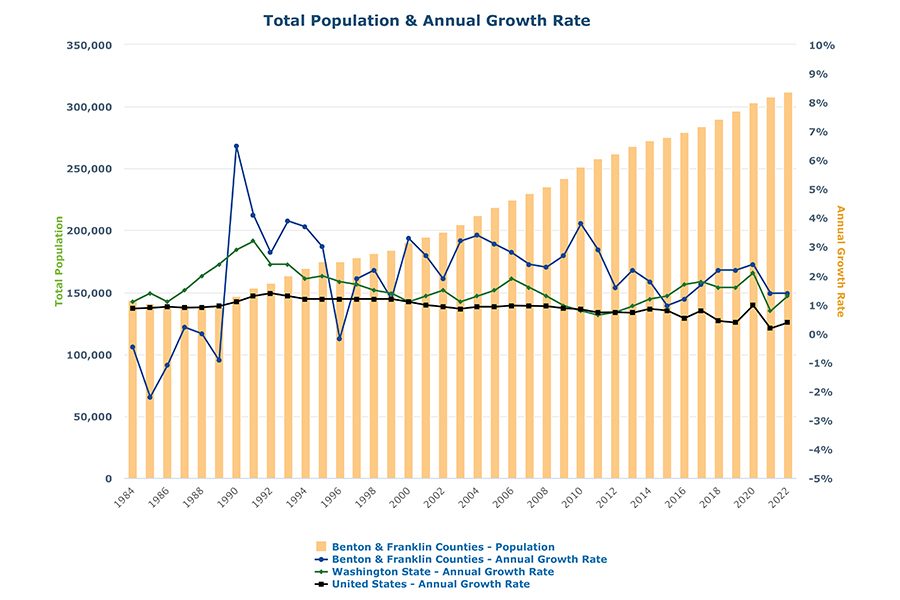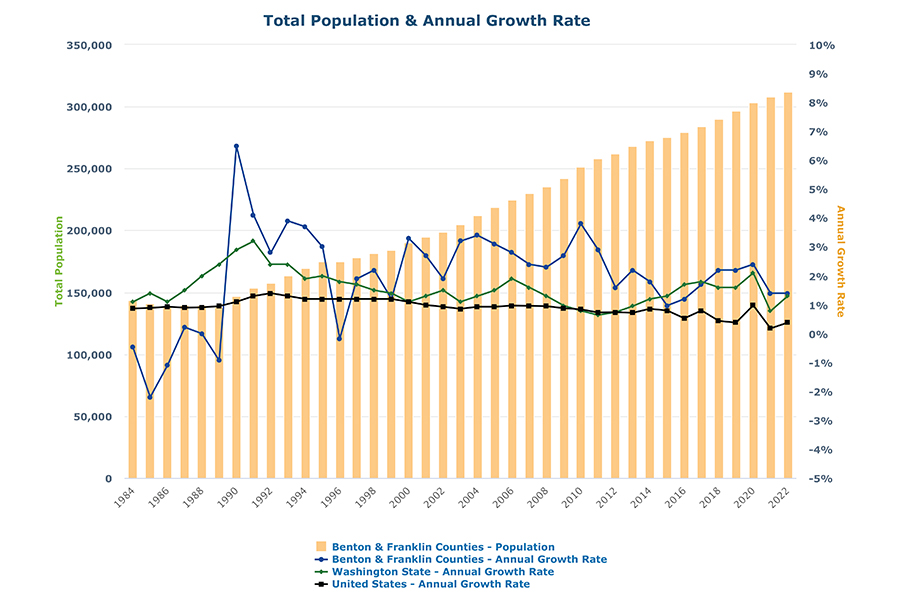
Home » Rapidly growing population raises stakes for replenishing professional pipeline
Rapidly growing population raises stakes for replenishing professional pipeline

January 11, 2023
Recent population leaps in the greater Tri-City region show no signs of abating.
That’s the takeaway from the demographers of the Washington Office of Financial Management (OFM). In its Growth Management (GMA) forecast released before Christmas, OFM now puts the likely total headcount of the two counties in 2025 at nearly 327,000, a gain of about 23,000.
Expressed as a cumulative growth rate between 2022-25, the forecast sees a 5% gain, tied with Mason County as the fastest growing metro area in the state. Among Washington counties, the fastest growing continues to be Franklin County, projected to add 6% of residents to its 2022 count by 2025.
The 2017 GMA estimate for 2020 undershot the Census count of that year by 8%.
As a consequence, OFM has adjusted its model so that the 2022 outlook represents an 8% to 12% increase for the current decade, depending on the year, over what it foresaw five years earlier.
This dynamic has led the demographers to predict total population here will reach 350,000 in 2030. As Benton-Franklin Trends data reveals, it was two short years ago that local population breached the 300,000 mark.
This relatively fast growth brings with it many implications for the area. One is workforce.
Let’s assume that 2025 population age mix isn’t too different than what we now observe. That implies about 85% of the population will be 16 years or older, or nearly 200,000.
Let’s also assume that labor force participation rate in 2025 remains approximately what it is today, about 63%. This implies another 12,300 added to the civilian workforce in the greater Tri-Cities in the next 36 months.
As this edition of the Tri-Cities Area Journal of Business focuses architects, engineers and lawyers, what does the projected population and workforce growth imply for these occupations?
Will there be much change in the next 36 months in the mix of occupations here?
Some, such as warehouse and transportation (logistics) jobs will loom larger, when the Amazon fulfillment center opens. But overall I would not expect significant shifts, as most local economies don’t change quickly in the short run.
As of 2021, these professions, with some of their ancillary occupations such as technicians or drafters included, amounted to about 4% of the two county ranks of the employed.
If the economy stays with this mix and at the employment rate we observed for 2021, we might then see nearly 500 jobs added to these occupations by 2025.
The bulk of the gain will occur in the engineering professions. They are, by far, the largest in this collection of occupations, formerly called “white collar” jobs.
In 2021, economists at Washington State’s Employment Security (ESD) office put the count of engineers employed here at over 3,500. Add in drafters, managers and technicians, the total engaged in engineering work in the two counties is easily 4,500.

Fold into the current count the number of accountants and auditors, at slightly over 850; lawyers/ paralegals at approximately 500; and architects, at about 50.
If ESD detailed forecasts are correct, however, accountants and auditors will experience the fastest rate of growth among these professions.
Why should we care? From a regional economic perspective, these professions enjoy some of the highest wages paid locally. Those wages contribute to the pool of income that is spent largely on local goods and services. Those expenditures, in turn, help fill the coffers of local government and other taxing districts.
According to another ESD data product, “Occupational Employment & Wage Survey,” these were the average annual wages in the greater Tri-Cities in 2021: accountants and auditors, at $80,690; architects, at $88,700; engineers, ranging from $93,000 to $129,000; and lawyers: $126,000.
The supporting occupations to these professions paid less, but still all above the overall annual average wage of $58,800 in the greater Tri-Cities.
While near-term population growth is pretty much assured, not assured is the incoming supply of these professions. The challenge seems most acute for accountants.
A recent Wall Street Journal article highlighted the difficulties accounting and audit firms face: a dwindling supply of recent college graduates and rising departures from the profession, not necessarily tied to retirements.
Finding the right mix in the engineering pool likely will also pose challenges to local firms. While the state’s higher education institutions have had some success in boosting enrollment in engineering, a likely wave of retirements will keep this market tight. For nuclear engineering positions, even tighter.
All in all, the pains of a growing population and workforce are good ones to have. For a smooth acceleration of the local economy, let’s hope that our country’s labor markets, internationally among the most fluid, can answer the call. And let’s hope that young professionals from the Tri-Cities will be part of the solution.
D. Patrick Jones is the executive director for Eastern Washington University’s Institute for Public Policy & Economic Analysis. Benton-Franklin Trends, the institute’s project, uses local, state and federal data to measure the local economic, educational and civic life of Benton and Franklin counties.
Architecture & Engineering Opinion
KEYWORDS january 2023




